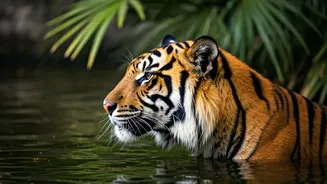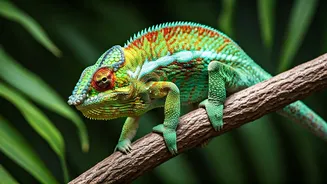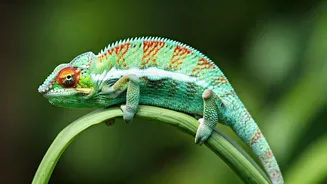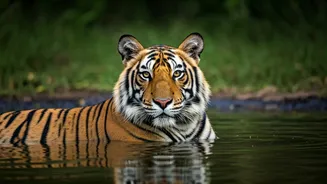Monarch Butterfly's Orange
The monarch butterfly, renowned for its incredible migratory journey, showcases a stunning display of orange and black. Its vivid orange wings serve as a warning
sign, communicating to potential predators that the butterfly is toxic due to the milkweed it consumes during its larval stage. This aposematic coloration, or warning signal, provides the monarch with a vital defence mechanism. The monarch's migration is a marvel of nature, with these butterflies travelling thousands of miles across generations. Their bright colour not only helps them stand out but also plays a vital role in their survival, advertising their unpalatability to predators. This butterfly's life cycle, from egg to caterpillar to chrysalis to adult, is as fascinating as its coloration.
Tiger's Stripes & Hues
Tigers, the largest of all wild cat species, are famous for their orange coats. This vibrant fur, combined with black stripes, provides them with camouflage in their grassy and forested habitats. The specific pattern of stripes is unique to each tiger, much like a human fingerprint. The orange colour allows them to blend in with the sunlight filtering through the vegetation, making them effective ambush predators. This camouflage is crucial for their survival, allowing them to stalk prey undetected. Moreover, their striking appearance has made them a symbol of beauty and power, though their existence is threatened by habitat loss and poaching. The conservation of tigers is essential for maintaining biodiversity in the environments they inhabit.
Koi Fish and Orange
Koi fish, domesticated varieties of the common carp, are known for their beautiful colours, including vibrant oranges, reds, whites, and blacks. These fish are popular in ornamental ponds and water gardens worldwide. The orange coloration in koi, developed through selective breeding over centuries, is a sought-after trait. The different colour patterns and types of koi are also highly valued, with specific variations like the Kohaku (white with red markings) and Sanke (white with red and black markings) being particularly prized. Beyond aesthetics, koi symbolize prosperity and good fortune in many cultures, further contributing to their popularity. The care of koi fish involves maintaining optimal water quality and providing a balanced diet to ensure their health and vibrant colours.
Mandarin Duck's Plumage
The male Mandarin duck is one of the most colourful waterfowl globally, displaying striking orange feathers as part of its vibrant plumage. This bright colouration is particularly pronounced during the breeding season. The male duck also has other striking hues like purples, greens, and blues, which contribute to its stunning appearance. Mandarin ducks often reside in forested areas near shallow lakes and ponds. This bird's vibrant colour plays a significant role in courtship and attracting mates, as well as providing camouflage within the diverse habitats they inhabit. Mandarin ducks are known for their monogamous relationships. Conservation efforts are crucial to protect their natural habitats and secure the survival of this exquisite species.
Fire Salamander’s Vivid Hues
Fire salamanders are amphibians famous for their striking black and yellow or orange markings. The bright colours serve as a warning signal, indicating the salamanders' toxicity to potential predators. They secrete a poison through their skin, making them unpalatable. The vivid colours, a form of aposematism, warn predators to avoid them. They are primarily found in Central and Southern Europe, inhabiting moist, forested environments. These salamanders have a nocturnal lifestyle, often found near streams and springs. Conservation is crucial for fire salamanders, as they face threats from habitat destruction and pollution, which endanger their population. Protecting their habitats and ecosystems ensures their survival and the preservation of biodiversity.
Sea Star's Vibrant Display
Many species of sea stars, also known as starfish, showcase vibrant orange hues, especially in the ocean depths. These colours help them blend into their surroundings, offering camouflage. The vibrant display also helps in attracting mates. These marine animals play a key role in their marine habitats by preying on shellfish and other invertebrates, thereby regulating populations. Sea stars possess remarkable regenerative abilities. Their vibrant orange colours can vary in intensity depending on the species and environmental conditions. Conservation efforts, such as reducing pollution and protecting coral reefs, are essential to preserve the habitats of these colourful marine animals and the health of the oceans.













